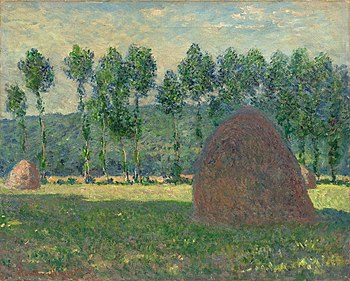You can help expand this article with text translated from the corresponding article in Russian. (March 2023)Click [show] for important translation instructions.
|

Haystack Near Giverny is an oil on canvas painting by Claude Monet, from 1884. It is held in the Pushkin Museum, in Moscow. It is a precursor to his 1890s Haystacks series.
It was bought by Paul Durand-Ruel in 1906 and in spring 1907 he sold it on to Ivan Morozov. A letter from Durand-Ruel on 27 May 1907 confirms he received 10,000 francs from Morozov for that work and 40,000 francs for A Corner in the Garden at Montgeron - the former arrived in Moscow on 10 October that year. [1] His collection was seized by the state after the October Revolution - the painting was assigned to the State Museum of Modern Western Art until its closure in 1948, then moved to its present location. [2]